 I have the .358-378RG project gun in the works for the Real Guns site, and it’s been moving along pretty well. The chambering reamers are in progress, the reloading die set is in progress and it looks like we have a winner for the service that will provide the custom stock and metal work. The base rifle was to be a Ruger No.1 Tropical, chambered for the .375 H&H round. I purchased mine from Paul over at Reeds Sporting Goods in San Jose, CA. Good price, good service, good inventory and special order service when necessary. They also carry a full line of accessories and reloading supplies and equipment. No, I do not get a price break at Reeds. In fact, I believe my sterling personality is the basis of a 10% surcharge.
I have the .358-378RG project gun in the works for the Real Guns site, and it’s been moving along pretty well. The chambering reamers are in progress, the reloading die set is in progress and it looks like we have a winner for the service that will provide the custom stock and metal work. The base rifle was to be a Ruger No.1 Tropical, chambered for the .375 H&H round. I purchased mine from Paul over at Reeds Sporting Goods in San Jose, CA. Good price, good service, good inventory and special order service when necessary. They also carry a full line of accessories and reloading supplies and equipment. No, I do not get a price break at Reeds. In fact, I believe my sterling personality is the basis of a 10% surcharge.
 What will remain of this little gun after modification is the action, and therein lies the problem. There is something very special about a gun chambered for the .375 H&H, especially when it carries an appearance more closely aligned with express rifles from the old British firms of the early 20th century. I can recall removing some guns from the box and wondering how quickly I could change stocks or barrels or sights. This time, I unpacked the Ruger and immediately began thinking of alternative donor rifles for my Real Guns project. I also immediately abandoned the notion of not firing the rifle before it’s barrel change and conversion.
What will remain of this little gun after modification is the action, and therein lies the problem. There is something very special about a gun chambered for the .375 H&H, especially when it carries an appearance more closely aligned with express rifles from the old British firms of the early 20th century. I can recall removing some guns from the box and wondering how quickly I could change stocks or barrels or sights. This time, I unpacked the Ruger and immediately began thinking of alternative donor rifles for my Real Guns project. I also immediately abandoned the notion of not firing the rifle before it’s barrel change and conversion.
The Ruger is a very compact gun, if not a light weight gun. With 24″ barrel, the No.1 measures barely 40″ long. Comparatively speaking, a Weatherby Euromark .378 or .416 WM is over 48″ long with a 26″ barrel and brake installed. Weatherby claims a weight of 9.5 lbs, but my .416 is a featherweight at 8.25 lbs. Ruger, on the other hand, was fibbing like a fat guy without a scale, the No.1 had an actual weight of 10 lbs. Since the gun is chambered only for either the .416 Rigby, or .375 H&H, most sane owners will look at the slender live rubber recoil pad, and not complain about weight.
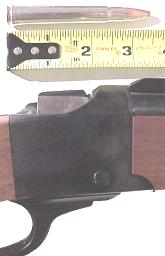 What we have here is an example of the magic trick single shot rifles can perform; how to feed a 3.5″ cartridge through a 2.5″ action, when a bolt action rifle needs an action with an ejection port longer than the cartridge, plus room for the bolt handle lock up and bolt locking lugs. The Weatherby Mark V, as an example, is approximately 6″ long.
What we have here is an example of the magic trick single shot rifles can perform; how to feed a 3.5″ cartridge through a 2.5″ action, when a bolt action rifle needs an action with an ejection port longer than the cartridge, plus room for the bolt handle lock up and bolt locking lugs. The Weatherby Mark V, as an example, is approximately 6″ long.
That silver block on top of the Ruger action is the falling block, or the heavy duty part that stands between the shooter and the rear of the cartridge when the breech is closed. The action need only accommodate the lever or opening mechanism and the breech block. The lever is pulled down, the block follows, and the long cartridge slides up over the top and forward into the chamber. The action length does not vary for cartridge length, rather only to adjust for the size of the block and less or greater strength. The action is very simple, very strong and will hold up to Weatherby type chamber pressures.
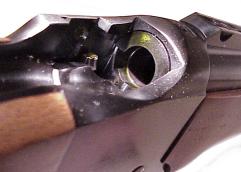 This is what the breech looks like with the block down and out of the way. Essentially there is a groove on top of the block for cartridge clearance and a wide open shot at the chamber.
This is what the breech looks like with the block down and out of the way. Essentially there is a groove on top of the block for cartridge clearance and a wide open shot at the chamber.
The assembly is comprised of a heavy barrel surrounding the chamber, wrapped in a very heavy receiver, backed up with a 2″ thick solid steel block, riding in solid steel tracks that run the full height of the block. I don’t believe this action is going anywhere that’s unexpected when the hammer drops. Operation is very smooth, the lever swing is in a natural arc in context with the rifle hold, and the trigger pull is an even, crisp 4 lbs. Neat.
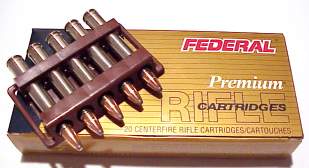 The price of ammo is relative. I almost never buy factory ammo, especially the premium type which can be handloaded for 25% the cost. This is Federal Safari with Nosler Partition 300 grain bullets. At $61 per box of 20, it’s a steal compared to Weatherby big cartridge ammo. And it comes in a 4 pack belt thingy for those who wish to look like a complete dude while out hunting. It sure is shiny with bright, blinding, highly reflective nickel cases. They aren’t even all that hot as a load. At 2530 fps MV, it starts at 4265 ft/lbs of ME. The Trophy bonded load is 200 fps faster, as is the Hornady Heavy Magnum load at half the price. Standard Winchester and Remington ammo can duplicate this performance
The price of ammo is relative. I almost never buy factory ammo, especially the premium type which can be handloaded for 25% the cost. This is Federal Safari with Nosler Partition 300 grain bullets. At $61 per box of 20, it’s a steal compared to Weatherby big cartridge ammo. And it comes in a 4 pack belt thingy for those who wish to look like a complete dude while out hunting. It sure is shiny with bright, blinding, highly reflective nickel cases. They aren’t even all that hot as a load. At 2530 fps MV, it starts at 4265 ft/lbs of ME. The Trophy bonded load is 200 fps faster, as is the Hornady Heavy Magnum load at half the price. Standard Winchester and Remington ammo can duplicate this performance
The last time I played around with handloads for this cartridge in a Ruger No.1, I could get to the high 2600’s in 300 grains before I started creating my own headstamps. By comparison, the .378 Weatherby factory load is a shoe in for 2900 fps, and can brush close to 3000 with a little nudge. The question might be raised, why bother pushing the .375 bore 300 grain bullet to this velocity? Well, the .375 is frequently used on tough African plains game, your basic 700 pound antelope, and long shots are not an exception. there are not a lot of bullet weights for this bore, but there are some very slippery and well constructed bullets. Personally, I have to believe this is the all around big gun for North America. You can load it pretty hot, but you can also load is down, a lot, and use it for just about anything.
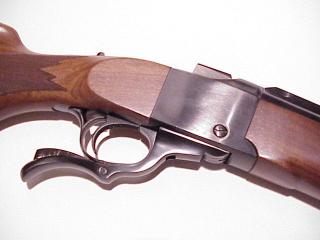 There are some details of the rifle I found very pleasing, especially in this price and power range.
There are some details of the rifle I found very pleasing, especially in this price and power range.
The bluing is luster finished and the stock is satin finished. I believe that’s what a hunting rifle is suppose to look like. It does, however, lose it’s dual purpose of weapon and reflecting mirror that other brands seem to offer. It also breaks the ugly plastic stock rule. Yes, the wood is plain grained, but it is cut cleanly, the finish is uniform all over and the metal parts are evenly blued. Of course the compulsory Ruger investment casting has found its way into the trigger guard, but is mostly hidden by the lever.
 The rear sight is an interesting proposition. The sight is a quarter-rib with a fold over leaf way up in the front. It would have been a lot nicer with the folding 3 leaf set they put on their M77 MkII Magnum rifles.
The rear sight is an interesting proposition. The sight is a quarter-rib with a fold over leaf way up in the front. It would have been a lot nicer with the folding 3 leaf set they put on their M77 MkII Magnum rifles.
A nice detail they did include was the Ruger ring notch set (see inset) that permit a scope to be clamped in place over the quarter rib. A not nice detail is rings are not included.
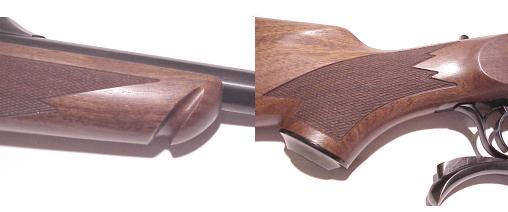
The wood and checkering are very nice. The wood is straight grained tough American walnut, the checkering is fine line and clean cut. My last Winchester and Remington rifles had checkering that looked as though they were cut with a dull branding iron. In fact, this is actually cleaner than the checkering on my Weatherby Euromark. I have no idea what that little groove is at the end of the forearm, someday when I have nothing to do and no intention of doing it, I’ll call Ruger and drive them crazy as they try to explain they don’t know either, only in more knowledgeable terms.
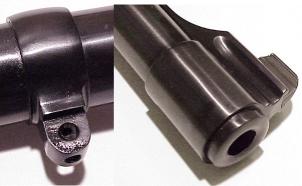 More nice detail; this time in metal work. The barrel band is a few inches up from the forearm and is positioned for much better balance with a sling carry. The rifle shipped with quick detachable swivels.
More nice detail; this time in metal work. The barrel band is a few inches up from the forearm and is positioned for much better balance with a sling carry. The rifle shipped with quick detachable swivels.
The muzzle in cleanly finished and it set off nicely with the front express sight. The only compliant is the very narrow blade and leaf combination which could easily be lost against an animal’s hide in anything but bright sunlight. I’d hang a scope on it and skip the open sights.
Now I’m at the difficult part. I will take the Ruger up to the range to see what it feels like in live fire, and to get a better sense of the personality of the rifle. Then I need to head scratch and figure out what appropriate modifications should be carried into the custom process. At the moment I’m considering not changing much, mostly upgrading what is already there. Then again, there is a sense that this could be an interesting combining of old tradition appearances and some interesting technology. I don’t know yet, so I’ll enjoy the luxury of thinking time while I’m waiting for parts to come in. In the mean time if you run across some interesting photos of single shot rifles, let me know.
Thanks
Joe

Email Notification